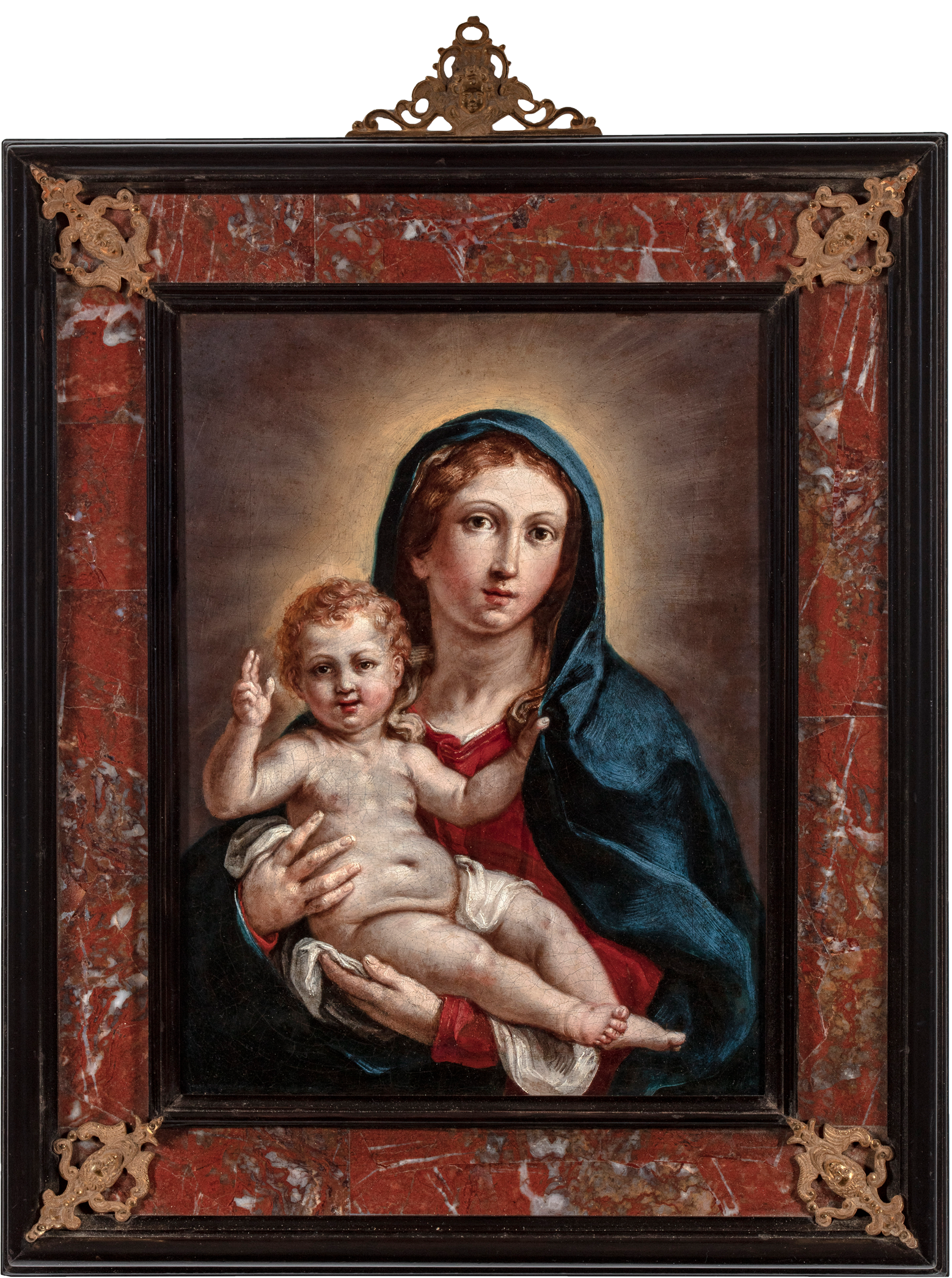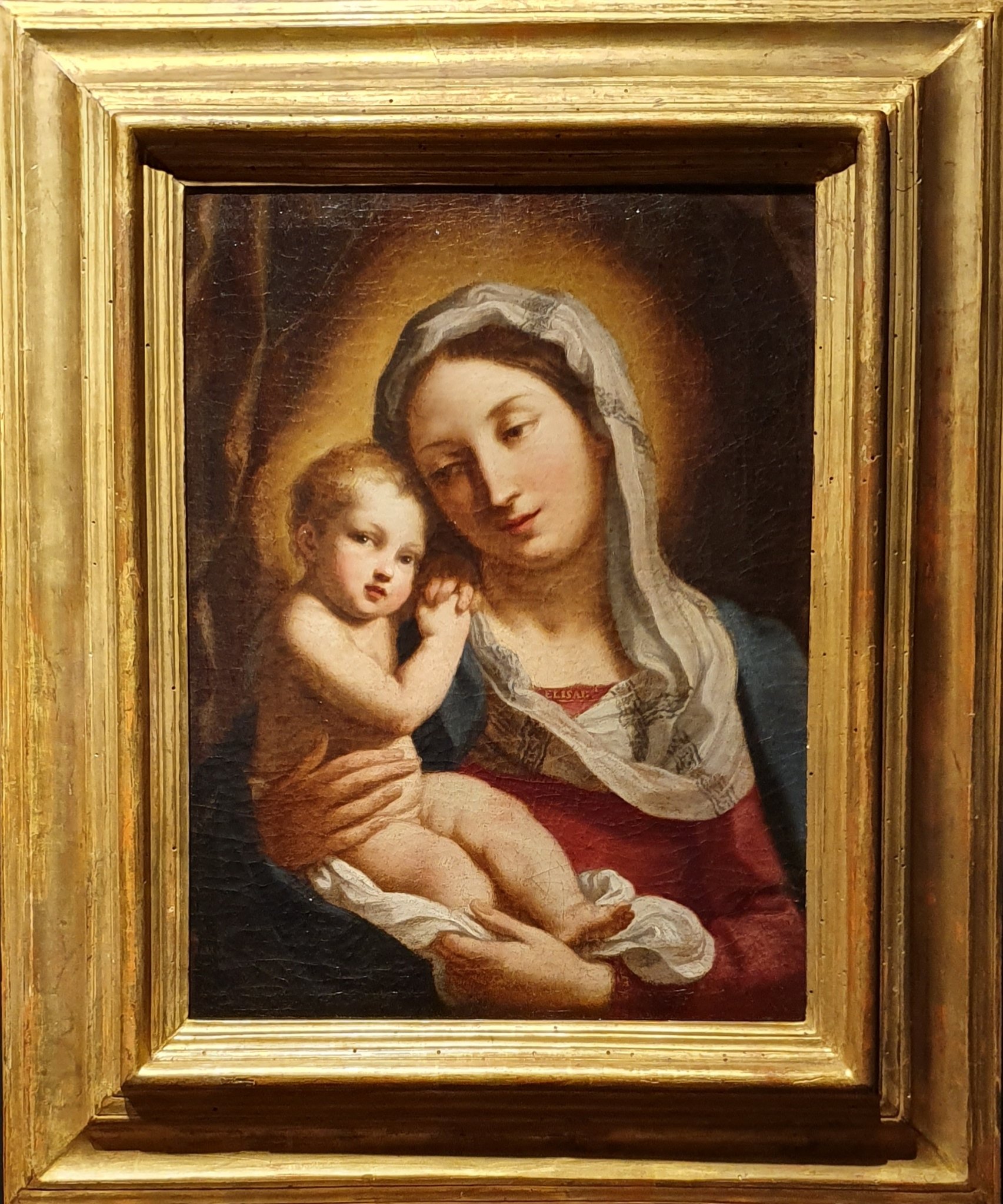ELISABETTA SIRANI
(Bologna, 1638 – 1665)
Madonna and Child
Oil on canvas
14 x 10 ⅝ inches (35.6 x 27 cm)
Provenance:
(Possibly) Commissioned by Cardinal Girolamo Farnese as gift for Henrietta Adelaide of Savoy, Duchess of Bavaria, 1663.
Beccari Collection, Italy, by the late 19th century, and by descent to:
Giuseppe Beccari (1943–2021), Reggio Emilia
Private Collection, Naples
Mercantinfiera, Parma, 2013
Private Collection, Cesena
Private Collection, Modena
Ossimoro Galleria d’Arte, Modena
Private Collection, Piacenza, since 2021
Literature:
(Possibly) Carlo Cesare Malvasia, “Nota delle Pitture fatte da me Elisabetta Sirani,” in Felsina Pittrice. Vite de’ Pittori Bolognesi, Bologna, 1678 (ed. G. Zanotti, 1841), vol. II, p. 398.
Adelina Modesti, Elisabetta Sirani ‘Virtuosa’: Women’s Cultural Production in Early Modern Bologna, Turnhout, 2014, pp. 42, 309, under cat. no. 88, fig. 65a.
Adelina Modesti, Elisabetta Sirani Pittrice nella Bologna del ‘600, ed. Sergio Bianchi, Modena, 2022, pp. 64-65, 72.
Adelina Modesti, Elisabetta Sirani, Los Angeles, 2023, p. 137.
Famously described by Carlo Malvasia as “the glory of the female sex, the gem of Italy, the sun of Europe,” Elisabetta Sirani enjoyed great renown across Europe for her prolific talent and reputed beauty. Daughter of Giovanni Andrea Sirani (1610–1670), Guido Reni’s principal assistant, she had begun painting by the age of 17, most likely training under her father, since as a woman she would not have had access to an academy. Sirani worked principally for private patrons, producing small-scale devotional works, as well as larger religious or historical pictures for aristocratic patrons, among them Grand Duke Cosimo III de’ Medici. She also executed altarpieces such as the Baptism of Christ (1658; Church of San Girolamo della Certosa, Bologna) and the Madonna Appearing to San Filippo Neri (1662; Church of Santa Maria di Galliera, Bologna). Upon her early death in 1665, aged just 27, she was immortalized in a series of poetic eulogies in which she was variously described as a “miracolo del Mondo” (“miracle of the world”), a female Apelles, even a Phoenix, the mythical bird who was continually reborn.[i]
This jewel-like Madonna and Child is a striking example of Elisabetta Sirani’s small-scale paintings. Works of this type are known as quadretti da letto, as they were often placed in the private spaces of the home, particularly in bedrooms. The intimacy of our painting, with its intense focus on the figures here placed close to the pictorial plane and brought into close proximity with the viewer, is especially well-suited to a painting intended for private devotion. The Virgin Mary presents the blessing Christ child to the viewer, encouraging both visual engagement and spiritual contemplation. Sirani has emphasized the divinity of these holy figures by painting them against a plain dark background that counterbalances the bright light of their halos. Working on this small scale, Sirani’s great sensitivity and masterful handling of paint are in full evidence. In addition to displaying an overall brightness associated more with a painting on copper than one on canvas, the subtle rendering of the flesh tones and the deep lapis lazuli blue of the Virgin’s mantle are especially striking. The facial type of the Virgin recurs throughout the artist’s oeuvre and most closely resembles Sirani’s Self-Portrait as an Allegory of Painting of 1658, in which the features are mirrored, with the figure’s head inclining to the left (Fig. 1).
Fig. 1. Elisabetta Sirani, Allegory of Painting, oil on canvas, 1658, Moscow, Pushkin Museum.
Adelina Modesti has suggested that our Madonna and Child is identifiable with one of two paintings recorded ca. 1662–1663 in Sirani’s list of her works, in which most of her surviving paintings can be identified (published by Malvasia in his biography of Bolognese artists Felsina Pittrice). She associated the picture with two successively described paintings: “A small half figure of a Madonna and Child, who is leaning against her shoulder as she sustains him on her arms, for the signor Cardinal Farnese” and “Another Madonna similar to this one both in scale as in disposition, because this was how he wished it for the Signora Duchess of Baveria.[ii]
The first of these paintings was commissioned by Girolamo Farnese, Cardinal of Bologna from 1658–1662, and the second by him as a gift for the Duchess of Bavaria, Enrichetta Adelaide of Savoy. Fiorella Frisoni has questioned this identification, pointing out that Christ is described by Malvasia as leaning on the Virgin’s shoulder (“sta appogiato ad una spalla”), which does not exactly correspond with our composition. Frisoni has proposed that Sirani’s paintings for Girolamo Farnese and the Duchess of Bavaria rather refer to a variant composition—one signed and unpublished in a private collection in Italy (Fig. 2) and the other, signed and dated 1663, of slightly smaller dimensions, formerly in a private collection in Budapest in 1940 and now in a private collection in Venezuela (Fig. 3).[iii]
Fig. 2. Elisabetta Sirani, Madonna and Child, oil on canvas, 48.1 x 36.5 cm, Private Collection, Italy.
Fig. 3. Elisabetta Sirani, Madonna and Child, oil on canvas, 38 x 28 cm, Private Collection, Venezuela.
Our painting dates from a moment in which the artist was only in her early twenties but had already found great success as a painter of private devotional pictures. Elisabetta Sirani’s authorship of this painting has been confirmed by Dr. Adelina Modesti, Dr. Fiorella Frisoni, and Dr. Emilio Negro (written communication).
[i] “La poesia muta celebrata dalla pittura loquace. Applausi di nobili ingegni al pennello immortale della Sra. Elisabetta Sirani pittrice bolognese,” 1666. See: Babette Bohn, “Il Fenomeno della Firma: Elisabetta Sirani,” in Elisabetta Sirani. “Pittrice Eroina” 1638–1665, exh. cat., Museo Civico Archeologico, Bologna, 2004-2005, pp. 113-114.
[ii] The lack of a definitive dating for the production of these paintings recorded by Sirani is due to the fact that she did not differentiate between the years 1662 and 1663 in her list.
[iii] For painting now in Venezuela, see: Adelina Modesti, Elisabetta Sirani ‘Virtuosa’, Turnhout, 2014, cat. no. 88, pp. 309-310. The painting is signed and dated “ELIS.TA” (on the neckline) and “SIRANI F. 1663” (on the sleeve hem).




